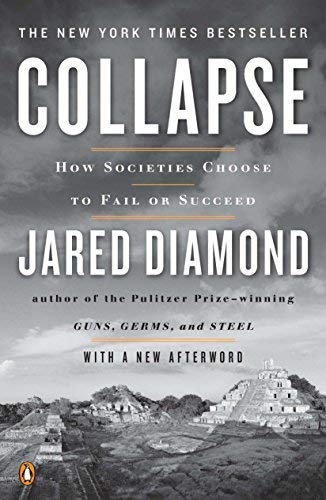Collapse: How Societies Decide between Failure and Success [Paperback]
Collapse: How Societies Choose to Fail or Succeed is a groundbreaking book penned by bestselling author and Pulitzer Prize-winning writer, Jared Diamond. In this thought-provoking work, Diamond explores the various factors that have led to the downfall of past civilizations and how these lessons can be applied to modern societies. Through a combination of historical case studies, environmental research, and societal analysis, Collapse delves deep into the complex interplay between human behavior, environmental degradation, and societal collapse. This compelling and insightful book challenges readers to consider the implications of our choices and actions on the future sustainability of our own society.

Collapse: How Societies Choose to Fail or Succeed Plot Summary
“Collapse: How Societies Choose to Fail or Succeed” is a groundbreaking book by Jared Diamond that explores the factors contributing to the collapse of past civilizations and offers insights to prevent the same fate for modern societies. The book is divided into five main chapters, each focusing on a different societal collapse or success story.
The first chapter, titled “Modern Montana”, serves as an introduction to the concept of collapse by discussing the near-collapse of the state of Montana due to environmental degradation and poor resource management. Diamond uses this case study to illustrate how the choices made by societies can have long-lasting consequences and how societies can learn from past mistakes.
The second chapter, “Past Societies”, delves into the collapse of ancient civilizations such as the Anasazi, Maya, and Easter Island societies. Diamond examines the various factors that led to their downfall, including environmental degradation, resource depletion, warfare, and political instability. By analyzing these historical collapses, Diamond highlights the importance of understanding the interconnectedness of social, economic, and environmental factors in shaping the fate of societies.
The third chapter, “The Modern World”, explores the challenges facing modern societies in the face of globalization, climate change, and resource depletion. Diamond argues that the choices made by individuals, communities, and governments today will determine the future of our planet. He emphasizes the need for sustainable practices and long-term planning to ensure the survival of our society in the face of impending environmental crises.
The fourth chapter, “The Natural World”, focuses on the impact of human activity on the natural environment and the consequences of environmental degradation. Diamond discusses the role of deforestation, pollution, and climate change in contributing to societal collapse and highlights the importance of conservation and sustainable resource management.
The final chapter, “The Future”, offers practical solutions to prevent societal collapse and ensure the long-term survival of our planet. Diamond emphasizes the importance of making informed choices based on scientific evidence and the need for cooperation between nations to address global challenges. He calls for a shift towards sustainable practices and a renewed appreciation for the interconnectedness of all living beings.
Overall, “Collapse: How Societies Choose to Fail or Succeed” is a thought-provoking and insightful exploration of the factors contributing to societal collapse and success. Diamond’s comprehensive analysis of past civilizations and modern challenges offers valuable lessons for individuals, communities, and policymakers on how to build a resilient and sustainable society for the future. By understanding the choices that led to the collapse of past societies, we can make informed decisions to ensure the survival of our planet and the well-being of future generations.
Collapse: How Societies Choose to Fail or Succeed Key Takeaway
One key takeaway from the book “Collapse: How Societies Choose to Fail or Succeed” by Jared Diamond is the importance of understanding and addressing environmental vulnerabilities in order to prevent societal collapse. Diamond examines case studies of past civilizations, such as the Maya, Easter Islanders, and Norse Greenlanders, to illustrate how environmental degradation, climate change, resource depletion, and other factors can contribute to the downfall of complex societies.
Diamond argues that societies can choose to thrive or fail based on their interactions with the environment and their ability to manage resources sustainably. He stresses the need for societies to recognize the limits of their ecosystems and make informed decisions to ensure long-term survival. By examining past collapses, Diamond provides valuable insights and lessons for contemporary societies facing similar challenges.
Overall, the key takeaway from “Collapse” is that societies have the agency to shape their own destinies through responsible stewardship of the environment. By learning from the mistakes of the past and actively working to mitigate environmental risks, societies can avoid the same fate as those that have collapsed before them. This book serves as a powerful reminder of the interconnectedness between human societies and their environments, and the importance of making informed choices for the future sustainability of our planet.
Conclusion
In Jared Diamond’s book Collapse: How Societies Choose to Fail or Succeed, he examines why some past societies have collapsed while others have endured. Through studying historical case studies and comparing them to modern societies, Diamond identifies common factors that lead to collapse, such as environmental degradation, climate change, political decisions, and societal values.
Ultimately, Diamond concludes that the choices societies make, both individually and collectively, play a critical role in determining their fate. He emphasizes the importance of being proactive in addressing challenges and making sustainable decisions to ensure the long-term survival of societies.
Overall, Collapse is a thought-provoking book that challenges readers to consider the impact of their actions on the environment and society as a whole. It serves as a cautionary tale and a call to action for individuals, corporations, and governments to prioritize sustainability and responsible stewardship of resources.
Readers who are interested in history, environmental science, sustainability, and sociology will find this book particularly compelling. They will appreciate Diamond’s accessible writing style, thorough research, and insightful analysis. Collapse is a must-read for anyone looking to better understand the complex interplay between human societies and the natural world.

No responses yet